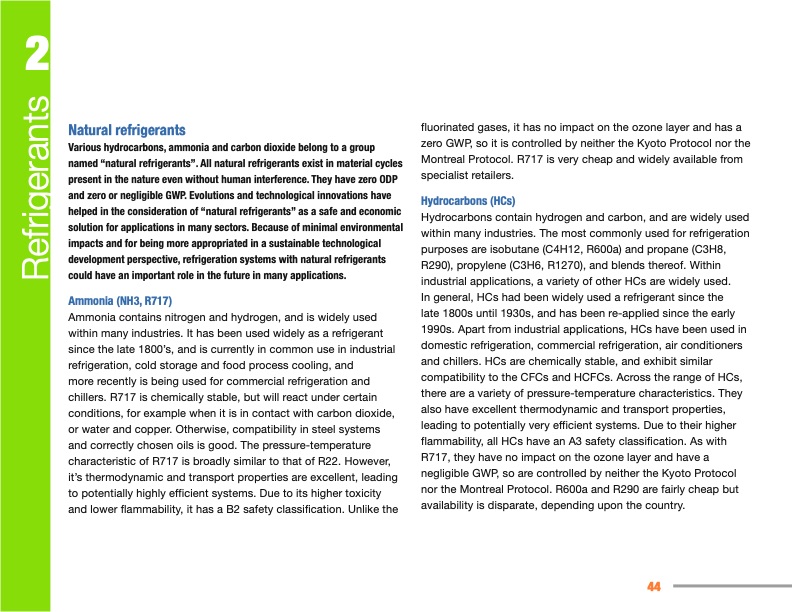
PDF Publication Title:
Text from PDF Page: 044
2 Natural refrigerants Various hydrocarbons, ammonia and carbon dioxide belong to a group named “natural refrigerants”. All natural refrigerants exist in material cycles present in the nature even without human interference. They have zero ODP and zero or negligible GWP. Evolutions and technological innovations have helped in the consideration of “natural refrigerants” as a safe and economic solution for applications in many sectors. Because of minimal environmental impacts and for being more appropriated in a sustainable technological development perspective, refrigeration systems with natural refrigerants could have an important role in the future in many applications. Ammonia (NH3, R717) Ammonia contains nitrogen and hydrogen, and is widely used within many industries. It has been used widely as a refrigerant since the late 1800’s, and is currently in common use in industrial refrigeration, cold storage and food process cooling, and more recently is being used for commercial refrigeration and chillers. R717 is chemically stable, but will react under certain conditions, for example when it is in contact with carbon dioxide, or water and copper. Otherwise, compatibility in steel systems and correctly chosen oils is good. The pressure-temperature characteristic of R717 is broadly similar to that of R22. However, it’s thermodynamic and transport properties are excellent, leading to potentially highly efficient systems. Due to its higher toxicity and lower flammability, it has a B2 safety classification. Unlike the fluorinated gases, it has no impact on the ozone layer and has a zero GWP, so it is controlled by neither the Kyoto Protocol nor the Montreal Protocol. R717 is very cheap and widely available from specialist retailers. Hydrocarbons (HCs) Hydrocarbons contain hydrogen and carbon, and are widely used within many industries. The most commonly used for refrigeration purposes are isobutane (C4H12, R600a) and propane (C3H8, R290), propylene (C3H6, R1270), and blends thereof. Within industrial applications, a variety of other HCs are widely used. In general, HCs had been widely used a refrigerant since the late 1800s until 1930s, and has been re-applied since the early 1990s. Apart from industrial applications, HCs have been used in domestic refrigeration, commercial refrigeration, air conditioners and chillers. HCs are chemically stable, and exhibit similar compatibility to the CFCs and HCFCs. Across the range of HCs, there are a variety of pressure-temperature characteristics. They also have excellent thermodynamic and transport properties, leading to potentially very efficient systems. Due to their higher flammability, all HCs have an A3 safety classification. As with R717, they have no impact on the ozone layer and have a negligible GWP, so are controlled by neither the Kyoto Protocol nor the Montreal Protocol. R600a and R290 are fairly cheap but availability is disparate, depending upon the country. 44 RefrigerantsPDF Image | Manual for Refrigeration Servicing Technicians

PDF Search Title:
Manual for Refrigeration Servicing TechniciansOriginal File Name Searched:
Refrigeration_Servicing.pdfDIY PDF Search: Google It | Yahoo | Bing
NFT (Non Fungible Token): Buy our tech, design, development or system NFT and become part of our tech NFT network... More Info
IT XR Project Redstone NFT Available for Sale: NFT for high tech turbine design with one part 3D printed counter-rotating energy turbine. Be part of the future with this NFT. Can be bought and sold but only one design NFT exists. Royalties go to the developer (Infinity) to keep enhancing design and applications... More Info
Infinity Turbine IT XR Project Redstone Design: NFT for sale... NFT for high tech turbine design with one part 3D printed counter-rotating energy turbine. Includes all rights to this turbine design, including license for Fluid Handling Block I and II for the turbine assembly and housing. The NFT includes the blueprints (cad/cam), revenue streams, and all future development of the IT XR Project Redstone... More Info
Infinity Turbine ROT Radial Outflow Turbine 24 Design and Worldwide Rights: NFT for sale... NFT for the ROT 24 energy turbine. Be part of the future with this NFT. This design can be bought and sold but only one design NFT exists. You may manufacture the unit, or get the revenues from its sale from Infinity Turbine. Royalties go to the developer (Infinity) to keep enhancing design and applications... More Info
Infinity Supercritical CO2 10 Liter Extractor Design and Worldwide Rights: The Infinity Supercritical 10L CO2 extractor is for botanical oil extraction, which is rich in terpenes and can produce shelf ready full spectrum oil. With over 5 years of development, this industry leader mature extractor machine has been sold since 2015 and is part of many profitable businesses. The process can also be used for electrowinning, e-waste recycling, and lithium battery recycling, gold mining electronic wastes, precious metals. CO2 can also be used in a reverse fuel cell with nafion to make a gas-to-liquids fuel, such as methanol, ethanol and butanol or ethylene. Supercritical CO2 has also been used for treating nafion to make it more effective catalyst. This NFT is for the purchase of worldwide rights which includes the design. More Info
NFT (Non Fungible Token): Buy our tech, design, development or system NFT and become part of our tech NFT network... More Info
Infinity Turbine Products: Special for this month, any plans are $10,000 for complete Cad/Cam blueprints. License is for one build. Try before you buy a production license. May pay by Bitcoin or other Crypto. Products Page... More Info
| CONTACT TEL: 608-238-6001 Email: greg@infinityturbine.com | RSS | AMP |